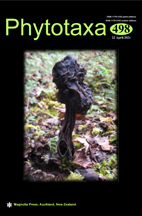Abstract
Myrtaceae is an important family in the neotropics, being highlighted for its relevance in a wide range of vegetations, including those found within the Espinhaço Mountain Range (EMR). The main goal of the present work was to analyze Myrtaceae floristic composition and vegetation distribution in the municipality of Mucugê, Chapada Diamantina, Bahia. Specimens were analyzed in herbaria, two field expeditions were carried out and a landcover classification was performed through remote sensing. The compiled dataset presented 438 records with valid taxonomical identification, from which 374 records were seen by the authors in herbaria. Nine genera and 66 species of Myrtaceae were found, representing the largest Myrtaceae diversity recorded in Chapada Diamantina so far. Four vegetation classes were detected in the landcover classification (campo rupestre, cerrado sensu lato, caatinga sensu lato, and evergreen forest), encompassing 12 phytophysiognomies validated in situ. Comparisons on species diversity within different classes of vegetation were made by overlapping the vegetation classification and Myrtaceae records, also highlighting a directional sampling effort, being the areas threatened by the agriculture expansion both subsampled and poorly known.

